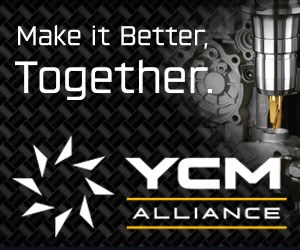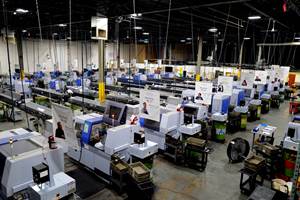Buying a Lathe: Slant-Beds and Multitasking Configurations
What are some variations on the basic lathe configuration? This can be helpful to review when considering the purchase of a new turning machine.
Share




When buying a turning machine, it can be helpful to be familiar with the various machine configurations available. Slant-bed lathes provide a number of advantages, while multitasking lathe configurations might open up possibilities heretofore unthought of.
Slant-Bed Lathes
The slant-bed lathe design is probably the most common and well-known configuration in today’s CNC lathes. Typically, the bed of the lathe slants at a 30- or 45-degree angle, although some 60-degree models also are available.
One obvious advantage to the slant-bed design is effective chip evacuation. Chips are simply washed into a chip conveyor or tray in the machine by the flow of coolant and the assistance of gravity. In high-volume production environments, evacuating chips quickly helps prolong the life of the machine by preventing them from accumulating where they may wear the machine ways or other moving parts.
Another advantage of slant-bed designs is larger X-axis travel. Unlike flatbed lathes in which the length of the guide rail is limited to the horizontal depth of the casting, the slant-bed design accommodates longer X-axis rails. This design also enables the slant-bed lathe to accept a larger part than a flatbed lathe with the same footprint.
Optimally, the headstock of a slant-bed lathe is mounted on the bed and shares the same 30- or 45-degree angle, parallel to the X axis and traveling on the same plane as the linear axes. Less-expensive models may be constructed with the base of the headstock at zero degrees (flat on the base and not slanted). This design makes the machine harder to get back in operation after a crash.
Multitasking Lathes
Multitasking machines are often built on a turning center platform. These machines use rotary tools to combine several cutting processes such as turning, milling, drilling, tapping, grooving, threading and deep-hole boring on one machine. It is not necessary to have multiple machines to handle those operations separately. Typically, multitasking turning centers have a second main spindle or an additional subspindle to which the workpiece can be transferred automatically from the first spindle. This enables continuous and simultaneous machining of first and second operations. The second spindle can grab the part for work on its back side to complete the part in one setup.
When a subspindle is used in conjunction with a bar feeder, the subspindle grabs the end of the bar and pulls out the length needed for the next part. The subspindle is more precise in pulling out the stock than the bar feeder is pushing it in.
After the parting tool severs the finished part, the subspindle can then drop it into the parts catcher while the main spindle begins machining the next part. The value of the parts catcher cannot be overstated as a reliable method for removing the finished part from the subspindle to make room for the next part.
With automatic subspindle workpiece transfer, a three-jaw or dead-length collet chuck is required. You don’t want a chuck or collet that may move in or out slightly to push or pull on the workpiece when clamping. This unwanted motion can easily mar the workpiece.
There’s virtually no limit to the variety of multitasking lathes that provide innovative part-processing combinations and superb performance. Twin main spindles and dual-turret configurations are two examples. It should be noted that it may be necessary to have separate part programs that can run simultaneously, each synchronized to avoid a collision. Shops that are new to the concept of multitasking on a lathe may not realize that new programming software and additional programmer training may be required to support these machines.
This is part four of a four-part series about buying turning machines.
- Part one: Buying a Lathe: The Basics
- Part two: Buying a Lathe: Turrets and Live Tooling
- Part three: Spindles and Tailstocks
Find more insights about acquiring a new machining center by visiting the Techspex Knowledge Center, “Guide to Buying Machine Tools.”
Related Content
4 Commonly Misapplied CNC Features
Misapplication of these important CNC features will result in wasted time, wasted or duplicated effort and/or wasted material.
Read MoreIndustry Analysis: Machining Semiconductor Components
With many machine shops anticipating long-term growth in demand from the semiconductor industry, it is worth the time to heed the advice of manufacturers who have already been servicing this end-market for years.
Read MoreInside the Premium Machine Shop Making Fasteners
AMPG can’t help but take risks — its management doesn’t know how to run machines. But these risks have enabled it to become a runaway success in its market.
Read MoreA History of Precision: The Invention and Evolution of Swiss-Style Machining
In the late 1800s, a new technology — Swiss-type machines — emerged to serve Switzerland’s growing watchmaking industry. Today, Swiss-machined parts are ubiquitous, and there’s a good reason for that: No other machining technology can produce tiny, complex components more efficiently or at higher quality.
Read MoreRead Next
Registration Now Open for the Precision Machining Technology Show (PMTS) 2025
The precision machining industry’s premier event returns to Cleveland, OH, April 1-3.
Read MorePicking the Right End Mill
Kennametal global product manager Katie Myers explains how cutting tool features can impact machining strategies for different materials.
Read MoreSetting Up the Building Blocks for a Digital Factory
Woodward Inc. spent over a year developing an API to connect machines to its digital factory. Caron Engineering’s MiConnect has cut most of this process while also granting the shop greater access to machine information.
Read More
















.jpg;maxWidth=300;quality=90)













